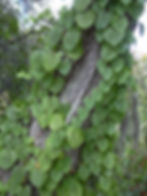Georgia’s rich ecosystems—from the mountains to the coast—are facing a growing threat from invasive plants. These non-native species spread aggressively, push out native flora, and disrupt ecosystems. Below are 15 of the most invasive plants currently threatening Georgia’s landscapes, how to recognize them, and what makes them so destructive.
1. Kudzu (Pueraria montana)
Origin: East Asia
Damage: Smothers native plants and trees, forms impenetrable mats.
Identification: Fast-growing vine with 3-lobed leaves and purple, grape-scented flowers in summer.

2. Chinese Privet (Ligustrum sinense)
Origin: China
Damage: Forms dense thickets that block light and reduce forest diversity.
Identification: Shrubby, with small oval leaves, white flowers in spring, and dark berries.

3. English Ivy (Hedera helix)
Origin: Europe
Damage: Kills trees by covering bark, reducing sunlight, and increasing disease vulnerability.
Identification: Waxy, lobed leaves on vines that climb trees or sprawl across the ground.

4. Japanese Honeysuckle (Lonicera japonica)
Origin: East Asia
Damage: Twines around and strangles other plants; outcompetes natives.
Identification: Fragrant white/yellow flowers, black berries, opposite leaves.

5. Tree-of-Heaven (Ailanthus altissima)
Origin: China
Damage: Releases chemicals into soil that inhibit native growth; grows rapidly.
Identification: Compound leaves with dozens of leaflets; foul odor when crushed.

6. Chinese Wisteria (Wisteria sinensis)
Origin: China
Damage: Smothers trees and native vegetation.
Identification: Woody vine with hanging purple flowers in spring and smooth leaflets.

7. Mimosa (Albizia julibrissin)
Origin: Asia
Damage: Disrupts native plant communities along roads and rivers.
Identification: Small tree with feathery leaves and pink, fluffy flowers.

8. Japanese Stiltgrass (Microstegium vimineum)
Origin: Asia
Damage: Forms dense carpets, reducing seed germination of native plants.
Identification: Grass with shiny leaves and silver mid-vein; weak stems form sprawling mats.

9. Air Potato (Dioscorea bulbifera)
Origin: Asia and Africa
Damage: Extremely fast-growing vine; blocks sunlight and crushes native species.
Identification: Heart-shaped leaves with aerial tubers (small potato-like nodules).

10. Autumn Olive (Elaeagnus umbellata)
Origin: Asia
Damage: Nitrogen-fixing shrub that disrupts native soil conditions and plant communities.
Identification: Silvery green leaves, yellow flowers, and red, speckled berries.

11. Liriope (Liriope muscari)
Origin: East Asia
Damage: Commonly used as ornamental groundcover, but spreads aggressively and suppresses native ground flora.
Identification: Grass-like leaves forming dense clumps, purple flower spikes in late summer.

12. Carolina Cherry Laurel (Prunus caroliniana)
Origin: Southeastern U.S. native, but acts invasively in disturbed or landscaped settings.
Damage: Rapid growth allows it to dominate forest understories and reduce biodiversity in urban forests and pine woodlands.
Identification: Evergreen shrub/tree with glossy, lance-shaped leaves and cherry-like black fruits.

13. Mahonia / Leatherleaf (Mahonia bealei)
Origin: China
Damage: Escapes from cultivation into forests, displacing native understory plants.
Identification: Evergreen shrub with holly-like, spiny leaves and yellow flowers followed by blue berries.

Invasive plant species pose a serious and ongoing threat to Georgia’s natural landscapes, choking out native vegetation, altering ecosystems, and reducing the habitat available for wildlife. While some of these plants may appear attractive or harmless—especially in landscaping—their impact on native biodiversity is far-reaching and often irreversible without intervention. Recognizing these species is the first step toward protecting Georgia’s rich ecological heritage. Whether you’re a gardener, landowner, hiker, or simply someone who loves the outdoors, your actions can make a difference. Choose native plants, stay informed, and spread awareness—because preserving Georgia’s native beauty starts with all of us.

